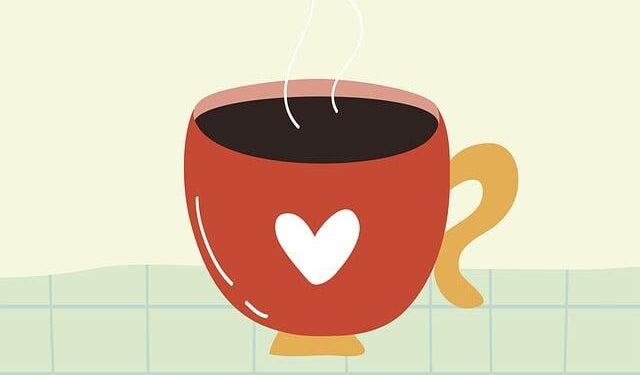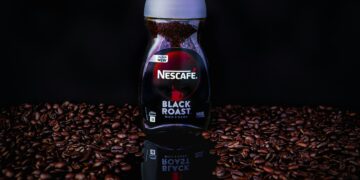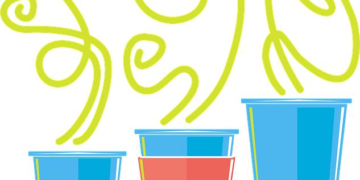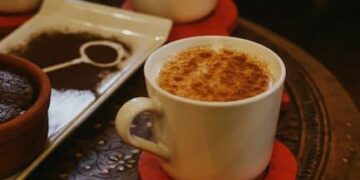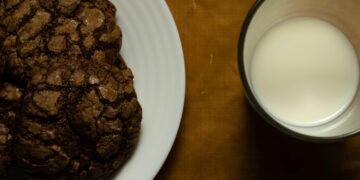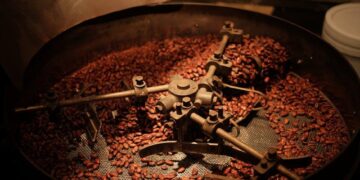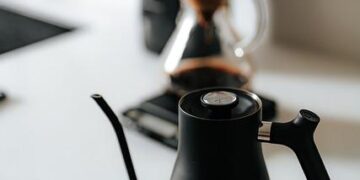Table of Contents
I’m a coffee person.
Not just a “need it to function” person, but someone who genuinely loves the ritual: the aroma, the first smooth sip, the gentle lift that carries you through the morning.
For me, cold brew is the pinnacle—less acidic, naturally sweeter, and impossibly smooth.1
So when I first spotted a bottle of Starbucks Cold Brew Concentrate on a grocery store shelf, it felt like I’d found a secret key.
The promise was irresistible: the café-quality taste I loved, but with the convenience and cost savings of making it at home.3
My first attempt was a disaster.
In a morning rush, I eyeballed a small splash of the dark liquid into my glass, added water and ice, and took a sip.
It was weak, watery, and profoundly disappointing.
“It’s concentrate,” I thought, “it must be stronger than this.”
The next day, I decided to correct my mistake.
I poured a generous amount—probably a good 8 ounces of the concentrate—directly over a full glass of ice, thinking, “more concentrate, more flavor.” I was right about the flavor.
It was bold and delicious.
But I was catastrophically wrong about the effect.
An hour later, my heart was racing.
My hands had a tremor I hadn’t felt since my college all-nighters.
By 3 PM, I was a wreck—a jittery, anxious mess, unable to focus on anything.
The afternoon was a total loss, all because of a cup of coffee.
This experience was a stark lesson in what a caffeine overdose feels like, a scenario others have unfortunately discovered with potent concentrates.4
Staring at the bottle that evening, I felt frustrated and betrayed.
The label was a puzzle of numbers and ratios that clearly didn’t communicate the full story.
I had followed what I thought was common sense and ended up with either a disappointing drink or a full-blown panic attack.
That’s when I realized I had to get to the bottom of it.
What on earth was actually in this bottle, and how was I, or anyone, supposed to use it correctly? This question launched me on a deep dive, a journey from a confused consumer to a confident home barista.
This is the story of what I Found.
In a Nutshell: Your Quick Guide to Starbucks Cold Brew Concentrate
For those who need answers now, here is the essential information.
The key is to understand that the caffeine content listed on the bottle is for the undiluted concentrate.
The final amount in your glass depends entirely on how you mix it.
- The Official Recipe: Starbucks recommends a 1:1 dilution ratio. This means you mix equal parts concentrate and water.5
- Signature Black Caffeine: When prepared as directed (6 fl oz of concentrate + 6 fl oz of water), a 12 fl oz serving of Starbucks Signature Black Cold Brew contains approximately 235 mg of caffeine.6
- Flavored Varieties: Flavored versions contain slightly less caffeine. For example, the Madagascar Vanilla and Caramel Dolce flavors have about 220 mg of caffeine per 12 fl oz prepared serving.7
- The Key Takeaway: You are the mixologist. The instructions are a recipe, not a rigid rule. By understanding the caffeine-per-ounce of concentrate, you can adjust the ratio to precisely control the caffeine level in your final drink.
The “Just Add Water” Maze: Why We’re All Confused About Caffeine
My disastrous experience wasn’t a personal failure; it was a symptom of a much larger problem.
As I dug into forums, product reviews, and Q&A sections, I found a chorus of confusion.
The core of the issue is that the term “concentrate” is dangerously ambiguous in the at-home coffee market.
It creates a mental model of high potency, like frozen orange juice, but lacks a standardized definition of how potent it Is.
This information gap is rampant.
On a Reddit thread titled, “Caffeine content of bottled Starbucks Cold Brew Concentrate,” the original poster explained they had to contact Starbucks customer support directly because the information was nowhere to be found online.9
The comments on that same thread devolved into a debate over whether the recommended serving was 4 oz or 6 oz of concentrate and whether the stated caffeine amount was for the concentrate itself or the final diluted drink—the very questions that had led to my jittery afternoon.9
This isn’t a problem unique to Starbucks.
On retail sites like Target, you can find brand representatives for various companies repeatedly answering the same fundamental questions from frustrated customers: “What is the caffeine content?” and “How much am I supposed to use?”.10
Reviews for Chameleon Cold Brew echo this sentiment perfectly, with one user writing, “How do you sell coffee and not list the caffeine content? It’s like selling T-Shirts and not giving the size”.11
The confusion stems from a fundamental disconnect between how these products are made, marketed, and understood.
- Non-Standardized Potency: Consumers see “concentrate” and logically assume a little goes a long way. However, there is no industry standard. Jot boasts a “20x” concentration 13, Stumptown sells a “2x” concentrate 14, and Starbucks, with its 1:1 dilution, is also effectively a 2x concentrate. Without a common reference point, the word “concentrate” is almost meaningless.
- Misleading Labeling: Brands often list the caffeine content for a serving of the undiluted concentrate (e.g., 235 mg per 6 fl oz of Starbucks concentrate).6 However, the instructions tell you to dilute it. This forces the consumer to perform mental calculations to figure out the caffeine in their actual drink.
- Cognitive Load: The combination of non-standard potency and confusing labels places a significant cognitive burden on the consumer. You’re not just buying coffee; you’re being asked to solve a math problem first thing in the morning. This design flaw is the true source of the “Just Add Water” maze.
The Mixologist’s Secret: A New Way to Think About Coffee Concentrate
After days of sifting through conflicting information and feeling increasingly frustrated, I had a breakthrough.
It happened while I was thinking about how other potent liquids are sold.
The problem wasn’t just the numbers; it was my entire mental framework for the product.
My epiphany was this: Cold brew concentrate isn’t a finished drink; it’s a cocktail base.
This simple analogy changed everything.
Think about it.
A bottle of Starbucks Cold Brew Concentrate is like a bottle of gin, whiskey, or any other base spirit.
You wouldn’t typically pour a full glass of gin and drink it straight.
Its primary purpose is to be a foundational ingredient in a mixed drink.
The bottle of concentrate is the same.
In this new framework:
- You are the Mixologist: You’re not just a passive consumer; you are the home barista, the creator of your own beverage. This shift in perspective is empowering.
- The Instructions are the Recipe: The 1:1 dilution ratio isn’t just a suggestion; it’s the recipe for the “signature cocktail.” Think of it as the recipe for a “Starbucks & Water” instead of a “Gin & Tonic.”
- The Goal is Mastery, Not Guesswork: A good mixologist knows their ingredients. They know the proof of their spirits and how to combine them to achieve a desired result. By understanding the “proof” (caffeine content) of your coffee concentrate, you can do the same.
This “Mixologist’s Secret” became my key to unlocking the puzzle.
It transformed the product from a source of confusion into a versatile tool.
Armed with this new mindset, I could finally deconstruct the bottle and build the perfect drink, every single time.
Deconstructing the Bottle: A Precise Guide to Starbucks® Cold Brew Concentrate
Applying the mixologist framework, the first step is to understand our “base spirit.” The most critical piece of information is not the caffeine in the concentrate, but the caffeine in the final, prepared drink when following the standard recipe.
Starbucks officially recommends a 1:1 dilution ratio, meaning you mix equal parts concentrate with water.5
The caffeine content listed on their “At Home” website is per serving of
concentrate.
Therefore, a final 12 fl oz drink (made with 6 fl oz of concentrate and 6 fl oz of water) contains the full caffeine load from that initial 6 fl oz of concentrate.
The table below clarifies the caffeine and calorie content for each flavor of Starbucks Cold Brew Multi-Serve Concentrate when prepared according to the official 1:1 recipe.
| Product Name | Caffeine per 6 fl oz of Concentrate (mg) | Recommended Serving (Concentrate + Water) | Caffeine in Final 12 fl oz Prepared Drink (mg) | Calories in Final 12 fl oz Prepared Drink | Source(s) |
| Signature Black | ~235 mg | 6 fl oz + 6 fl oz | ~235 mg | 15 | 6 |
| Sweetened Signature Black | ~225 mg | 6 fl oz + 6 fl oz | ~225 mg | 60 | 3 |
| Madagascar Vanilla | ~220 mg | 6 fl oz + 6 fl oz | ~220 mg | 15 | 7 |
| Caramel Dolce | ~220 mg | 6 fl oz + 6 fl oz | ~220 mg | 15 | 8 |
| Brown Sugar Cinnamon | ~205 mg | 6 fl oz + 6 fl oz | ~205 mg | 60 | 16 |
| Sweetened Vanilla & Chocolate | ~225 mg | 6 fl oz + 6 fl oz | ~225 mg | 60 | 15 |
This data reveals a crucial point.
A 12 fl oz (Tall) prepared serving of the at-home Signature Black concentrate contains about 235 mg of caffeine.
For comparison, a 16 fl oz (Grande) Cold Brew purchased in a Starbucks café contains 205 mg of caffeine.17
This means that on a per-ounce basis, the at-home version prepared as directed is significantly more potent than what you get in the store.
A Tall at-home brew has more caffeine than a Grande in-store brew.
This is a vital piece of information for anyone managing their intake.
The Dilution Equation: How to Master Your Own Caffeine Intake
The real beauty of the mixologist mindset is that it frees you from being locked into a single recipe.
The 1:1 ratio is simply Starbucks’ recommendation for achieving their signature flavor profile.3
But the product’s true value, as even the marketing suggests, is the ability to “make it yours”.3
By understanding the simple math, you gain complete control.
Let’s use the Signature Black concentrate as our base, which contains approximately 235 mg of caffeine in every 6 fl oz of concentrate.
That’s about 39 mg of caffeine per fluid ounce of concentrate.
This number is your key.
Here is a step-by-step guide to crafting your perfect drink:
- The Standard Recipe (The “Starbucks & Water”):
- Formula: 6 fl oz concentrate + 6 fl oz water.
- Result: A 12 fl oz drink with ~235 mg of caffeine. This is your baseline.
- The Half-Caf Method (For a Lighter Lift):
- Formula: 3 fl oz concentrate + 3 fl oz water.
- Result: A 6 fl oz drink with ~118 mg of caffeine. This is perfect for an afternoon coffee when you want the taste without the intense kick.
- The “Grande” at Home (Precision Control):
- An in-store Grande Cold Brew has 205 mg of caffeine.17 To replicate this, you need to calculate the right amount of concentrate.
- Formula: 205 mg÷39 mg/oz≈5.25 fl oz of concentrate.
- Result: Mix about 5.25 fl oz of concentrate with 5.25 fl oz of water for a 10.5 fl oz drink that has the same caffeine as an in-store Grande. You now have the power to match caffeine levels with precision.
- The “Bold” Method (Use with Caution):
- Some prefer a stronger taste and change the ratio to 2:1 (concentrate to water), a method mentioned in some online guides.19
- Formula: 6 fl oz concentrate + 3 fl oz water.
- Result: A 9 fl oz drink that still contains ~235 mg of caffeine. The caffeine dose is the same as the standard recipe, but it’s delivered in a smaller, more intense beverage. This is for those who want a bolder flavor, but be mindful of the concentrated caffeine hit.
The label on the bottle is a recipe, not a rule.
By knowing the caffeine-per-ounce of your concentrate, you are liberated.
You can create drinks with less caffeine, drinks that taste stronger, or drinks that perfectly match the caffeine content of other beverages.
The power shifts from the manufacturer to you, the home barista.
The Broader Brew: Placing Starbucks in the Competitive Cold Brew Landscape
Once you’ve mastered your Starbucks bottle, you can confidently approach the entire cold brew aisle.
The market is crowded and, as we’ve established, plagued by a lack of standardization that makes direct comparison difficult.20
To cut through the noise, we need to apply our mixologist framework and create normalized metrics to compare these “base spirits” on a level playing field.
The following table synthesizes data from dozens of sources to provide a true comparative analysis.
It normalizes for different bottle sizes, prices, and dilution ratios to give you three key metrics:
- Caffeine per Recommended Serving: How much caffeine you get when you follow the brand’s instructions.
- Caffeine per fl oz of Concentrate (Potency Score): A direct measure of how strong the concentrate is. This is invaluable for custom drinks.
- Approx. Cost per Serving: A normalized value to help you compare brands on price.
| Brand | Product Name/Variant | Bottle Size (fl oz) | Approx. Price | Recommended Dilution | Prepared Serving Size (fl oz) | Caffeine per Serving (mg) | Potency Score (mg/fl oz of concentrate) | Approx. Cost per Serving ($) | Source(s) |
| Starbucks | Signature Black Concentrate | 32 | $9.29 | 1:1 | 12 | ~235 | ~39.2 | $1.74 | 6 |
| Stumptown | 2x Cold Brew Concentrate | 25.4 | $11.99 | 1:1 | 12 | ~257 | ~42.8 | $2.84 | 14 |
| Chameleon | Black Coffee Concentrate | 32 | $9.49 | 1:1 | 12 | ~200-250 | ~33-42 | $1.78 | 11 |
| Wandering Bear | 3 to 1 Coffee Concentrate | 32 | $32.99 | 1:3 | 6 | 150 | 75.0 | $1.57 | 23 |
| Grady’s | New Orleans-Style Concentrate | 32 | $12.99 | 1:1 | 8 | 126 | 31.5 | $1.62 | 25 |
| Califia Farms | Cold Brew Concentrate | 32 | $8.02 | 1:1 | 8 | ~80-95 | ~20-24 | $1.00 | 27 |
| Jot | Ultra Coffee Concentrate | 6.8 | $26.00 | 1 tbsp per 8 oz | 8 | ~150 | 150.0 | $1.86 | 29 |
Note: Prices are approximate and can vary by retailer and location.
Caffeine content for some brands is provided as a range.
This data provides a wealth of clarity:
- The Potency Spectrum: The “Potency Score” reveals a vast difference in concentration. At one end, you have Jot, a true “ultra-concentrate” with a staggering 150 mg of caffeine per tablespoon (or 300 mg per oz).29 At the other end, you have
Califia Farms, which is significantly milder. Starbucks and Stumptown occupy a middle ground of strong, 2x-style concentrates. - Caffeine Value: While Jot appears expensive per bottle, its high concentration makes the cost-per-serving competitive. Wandering Bear and Califia Farms offer excellent value per serving for those seeking a more moderate caffeine dose.
- Information Gaps: It’s important to note the inconsistencies in reported data, especially for a brand like Chameleon, where different sources and even brand representatives provide slightly different ranges.11 This reinforces the need for consumers to be vigilant and rely on comprehensive guides like this one.
The Science of the Steep: Why Cold Brew is Smoother, and What That Means for Caffeine
To truly master our craft, a good mixologist needs to understand not just the ingredients, but the “distillation” process itself.
The unique properties of cold brew—its smoothness and its caffeine punch—are a direct result of the chemistry of its creation.
The fundamental difference between hot and cold brewing is the primary extraction variable: temperature versus time.1
Hot water (
195−205∘F or 90−96∘C) is an aggressive solvent, rapidly dissolving a wide range of compounds from the coffee grounds.
Cold brewing, which uses room temperature or chilled water, is a slow, gentle, and more selective process that can take anywhere from 12 to 24 hours.2
The Acidity Question
This difference in extraction method is why cold brew is famously less acidic.
Certain compounds, particularly chlorogenic acids, are highly soluble in hot water but much less so in cold water.32
By using cold water, the brewing process simply extracts fewer of these acidic-tasting compounds, resulting in a smoother, mellower flavor profile that many people, especially those with sensitive stomachs, find more pleasant.35
Scientific measurements confirm this, showing that cold brew coffee typically has a higher pH level (meaning it is less acidic) than its hot-brewed counterpart.34
The Caffeine Extraction Paradox
This leads to a common point of confusion: if hot water is a more efficient solvent, why does cold brew often have more caffeine? It seems like a paradox.
The answer lies in the two variables that cold brewing uses to compensate for its lack of heat: an extremely long steep time and a much higher coffee-to-water ratio.
- While hot water extracts caffeine more efficiently in the short term, steeping coffee grounds for 12 to 24 hours gives the cold water an immense amount of contact time to slowly but surely pull caffeine from the beans.33
- More importantly, cold brew concentrate is made with a much denser slurry of coffee. A typical drip coffee might use a ratio of 1:16 (1 part coffee to 16 parts water). A cold brew concentrate, however, might use a ratio of 1:8 or even as low as 1:4.19
So, while the extraction process is less aggressive moment-to-moment, the combination of a very long duration and a much greater mass of coffee grounds results in a final liquid—the concentrate—that is incredibly dense with dissolved solids, including caffeine.
This is how a gentler process can lead to a more potent product.
From Confused Consumer to Confident Barista: Your New Morning Ritual
My journey began with a 3 PM panic attack born of confusion.
It ended with the quiet confidence of a craftsman.
The “Mixologist’s Secret” didn’t just give me an answer; it gave me a new lens through which to see my morning ritual.
The frustration is gone, replaced by a sense of control and mastery.
My morning routine is now stress-free.
I no longer eyeball the concentrate with apprehension.
I grab my measuring spoon and confidently pour, knowing exactly what I’m creating.
On a busy day, I might make the standard 1:1 recipe for that 235 mg kick.
On a slower weekend, I might make a half-caf version to simply savor the taste.
The power is in my hands.
This journey has revealed five core truths that can transform your experience, too:
- Think Like a Mixologist: Your bottle of concentrate is a base ingredient. You are the creator, and the instructions are your first recipe.
- The 1:1 Ratio is Your Starting Point: For Starbucks concentrate, this standard recipe yields a potent 12 fl oz drink with roughly 205-235 mg of caffeine.
- You Are in Control: Know the caffeine-per-ounce of your concentrate (for Signature Black, it’s about 39 mg/oz). Use this number to adjust the ratio and craft a drink with the perfect caffeine level for you.
- Know the Market: The world of cold brew concentrate is vast and varied. Use the comparative data to explore other brands and find the best potency and value for your needs.
- Appreciate the Science: The smooth, rich flavor of your cold brew is no accident. It’s the direct result of a slow, gentle extraction process that favors time over temperature, creating a less acidic and uniquely delicious coffee.
The confusion surrounding cold brew concentrate isn’t your fault.
It’s the result of a new and non-standardized market.
But with the right framework and a little knowledge, you can navigate the maze with ease.
Welcome to the club of confident home baristas.
Your perfect cup of coffee, made exactly your way, is waiting.
Works cited
- The science behind cold brew extraction: How does it really work? – Hardtank, accessed August 2, 2025, https://hardtank.com/2025/05/06/science-of-cold-brew-extraction/
- Science Behind Cold Brew Coffee: Why It Tastes So Good, accessed August 2, 2025, https://chamberlaincoffee.com/blogs/inspiration/the-science-behind-cold-brew-coffee
- Starbucks® Cold Brew Multi-Serve Concentrate Sweetened Signature Black, accessed August 2, 2025, https://athome.starbucks.com/products/cold-brew-multi-serve-concentrate-sweetened-signature-black
- Why am I so sick from this cold brew : r/Coffee – Reddit, accessed August 2, 2025, https://www.reddit.com/r/Coffee/comments/4jwcmm/why_am_i_so_sick_from_this_cold_brew/
- How to Make Starbucks®️ Cold Brew Concentrates at Home, accessed August 2, 2025, https://athome.starbucks.com/how-to-guide/how-make-starbucks-cold-brew-concentrates
- Starbucks® Cold Brew Multi-Serve Concentrate Signature Black, accessed August 2, 2025, https://athome.starbucks.com/products/cold-brew-multi-serve-concentrate-signature-black
- Starbucks® Flavored Cold Brew Multi-Serve Concentrate Madagascar Vanilla, accessed August 2, 2025, https://athome.starbucks.com/products/cold-brew-flavored-multi-serve-concentrate-madagascar-vanilla
- Starbucks® Flavored Cold Brew Multi-Serve Concentrate Caramel Dolce, accessed August 2, 2025, https://athome.starbucks.com/products/cold-brew-flavored-multi-serve-concentrate-caramel-dolce
- Caffeine content of bottled Starbucks Cold Brew Concentrate. I …, accessed August 2, 2025, https://www.reddit.com/r/starbucks/comments/u945bl/caffeine_content_of_bottled_starbucks_cold_brew/
- Starbucks Cold Brew Coffee — Signature Black — Multi-Serve Concentrate — 1 bottle (32 fl oz.) – Target, accessed August 2, 2025, https://www.target.com/p/starbucks-cold-brew-coffee-8212-signature-black-8212-multi-serve-concentrate-8212-1-bottle-32-fl-oz/-/A-78295194
- Chameleon Cold Brew Black Coffee Concentrate – 32 fl oz – Target, accessed August 2, 2025, https://www.target.com/p/chameleon-cold-brew-black-coffee-concentrate-32-fl-oz/-/A-16558973
- 32 oz ESPRESSO COLD-BREW COFFEE CONCENTRATE, accessed August 2, 2025, https://chameleoncoffee.com/products/espresso-cold-brew-concentrate-32oz
- Jot Jot Coffee Concentrate (Original) High Caffeine Cold Brew Coffee Concentrate Liquid for Iced Coffees, Instant Espresso, Hot or Cold Instant Coffees – Makes 14 Cups, 150mg Caffeine/Tbsp, Sugar Free – IBSPOT, accessed August 2, 2025, https://ibspot.com/us/products/jot-jot-coffee-concentrate-original-high-caffeine-cold-brew-coffee-concentrate-liquid-for-iced-coffees-instant-espresso-hot-or-cold-instant-coffees-makes-14-cups-150mg-caffeine-tbsp-sugar-free
- Stumptown Cold Brew Coffee Concentrate – 25.4 fl oz – Smith Brothers Farms, accessed August 2, 2025, https://www.smithbrothersfarms.com/stumptown-cold-brew-concentrate
- Starbucks® Cold Brew Multi-Serve Concentrate Sweetened Vanilla & Chocolate, accessed August 2, 2025, https://athome.starbucks.com/products/starbucks-cold-brew-multi-serve-concentrate-sweetened-vanilla-chocolate
- Starbucks® Cold Brew Multi-Serve Concentrate Flavored Brown Sugar Cinnamon, accessed August 2, 2025, https://athome.starbucks.com/products/starbucks-cold-brew-multi-serve-concentrate-Brown-Sugar-Cinnamon
- How Much Caffeine in a Cup of Starbucks Coffee? – CAFELY, accessed August 2, 2025, https://cafely.com/blogs/info/how-much-caffeine-starbucks-coffee
- Starbucks Caffeine Levels – Reddit, accessed August 2, 2025, https://www.reddit.com/r/starbucks/comments/13d7a78/starbucks_caffeine_levels/
- How to Make Starbucks Cold Brew Coffee Concentrate at Home, accessed August 2, 2025, https://bazancoffee.com/blogs/recipe/starbucks-cold-brew-coffee-concentrate
- 6 Best Coffee Concentrates for Easier Mornings, Tested and Reviewed – Taste of Home, accessed August 2, 2025, https://www.tasteofhome.com/collection/best-coffee-concentrate/
- Best Cold Brew Coffee We Found in a Taste Test – Sporked, accessed August 2, 2025, https://sporked.com/article/best-cold-brew/
- How much caffeine do your Cold Brew products have? – Stumptown Support, accessed August 2, 2025, https://support.stumptowncoffee.com/hc/en-us/articles/5713883144589-How-much-caffeine-do-your-Cold-Brew-products-have
- Organic Cold Brew Concentrate (32 oz) – Wandering Bear Coffee, accessed August 2, 2025, https://wanderingbearcoffee.com/products/3-to-1-coffee-concentrate-6-pack
- Organic Cold Brew Concentrate (32 oz) – Wandering Bear Coffee, accessed August 2, 2025, https://wanderingbearcoffee.com/products/3-1-coffee-concentrate
- www.gradyscoldbrew.com, accessed August 2, 2025, https://www.gradyscoldbrew.com/pages/questions#:~:text=How%20much%20caffeine%20is%20in,contains%203.4mg%20of%20caffeine.
- Order Grady’s All Natural Cold Brew Coffee Concentrate, Glass Bottle – Fresh Direct, accessed August 2, 2025, https://www.freshdirect.com/supergro/bev/sc/gro_bever_icecoff/p/gro_pid_4007147
- Califia Farms Pure Black Medium Roast Cold Brew Coffee – 48 fl oz – Target, accessed August 2, 2025, https://www.target.com/p/califia-farms-pure-black-medium-roast-cold-brew-coffee-48-fl-oz/-/A-52172630
- Califia Farms Cold Brew Coffee Concentrate 32 Fluid Ounces – Walmart.com, accessed August 2, 2025, https://www.walmart.com/ip/Califia-Farms-Cold-Brew-Coffee-Concentrate-32-Fluid-Ounces/191975621
- jot.co, accessed August 2, 2025, https://jot.co/blogs/the-hopper/what-is-coffee-concentrate#:~:text=Jot%20Ultra%20Coffee%20(liquid%20coffee,Espresso%3A%2030%20mg%20per%20tablespoon
- Jot Coffee Review 2025: Pros, Cons & Verdict, accessed August 2, 2025, https://cornercoffeestore.com/jot-coffee-review/
- How Much Caffeine Is in Chameleon Cold Brew Coffee? 2025 Breakdown, accessed August 2, 2025, https://cornercoffeestore.com/how-much-caffeine-in-chameleon-cold-brew-coffee/
- The Chemistry of Brewing Cold Brew Coffee: A Deep Dive, accessed August 2, 2025, https://torque.coffee/blogs/brew-guides/the-chemistry-of-brewing-cold-brew-coffee-a-deep-dive
- The Science of Cold Brew Coffee – FoodCrumbles, accessed August 2, 2025, https://foodcrumbles.com/science-cold-brew-coffee/
- Is cold brew less acidic than coffee? – Breville, accessed August 2, 2025, https://www.breville.com/us/en/blog/coffee-and-espresso/is-cold-brew-less-acidic.html
- primulaproducts.com, accessed August 2, 2025, https://primulaproducts.com/a/blog/is-my-coffee-less-acidic-with-a-cold-brew-coffee-maker#:~:text=The%20main%20reason%20why%20cold,and%20acidity%20of%20the%20coffee.
- Does My Cold Brew Coffee Maker Make Less Acidic Coffee? – Primula Products, accessed August 2, 2025, https://primulaproducts.com/a/blog/is-my-coffee-less-acidic-with-a-cold-brew-coffee-maker
- Does Cold Brew Have More Caffeine? The Caffeine Content Dilemma Unfolded., accessed August 2, 2025, https://www.cooperscoffeeco.com/does-cold-brew-have-more-caffeine-the-caffeine-content-dilemma-unfolded/
